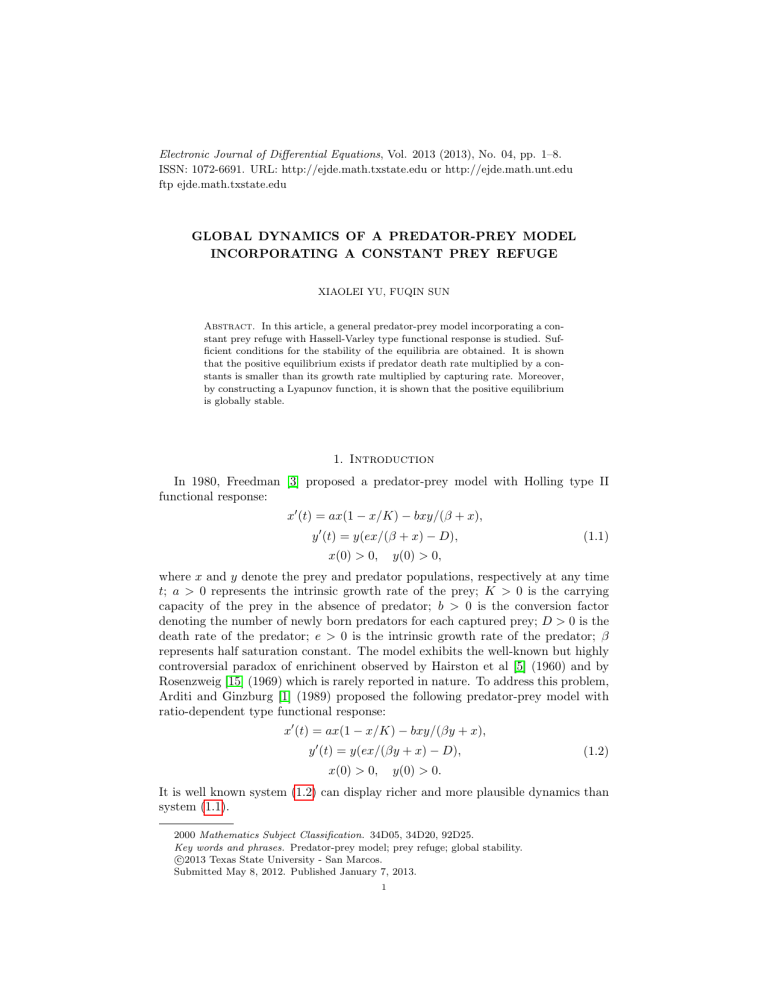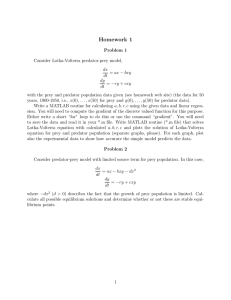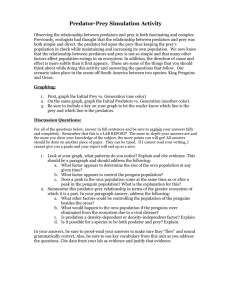Electronic Journal of Differential Equations, Vol. 2013 (2013), No. 04,... ISSN: 1072-6691. URL: or
advertisement

Electronic Journal of Differential Equations, Vol. 2013 (2013), No. 04, pp. 1–8.
ISSN: 1072-6691. URL: http://ejde.math.txstate.edu or http://ejde.math.unt.edu
ftp ejde.math.txstate.edu
GLOBAL DYNAMICS OF A PREDATOR-PREY MODEL
INCORPORATING A CONSTANT PREY REFUGE
XIAOLEI YU, FUQIN SUN
Abstract. In this article, a general predator-prey model incorporating a constant prey refuge with Hassell-Varley type functional response is studied. Sufficient conditions for the stability of the equilibria are obtained. It is shown
that the positive equilibrium exists if predator death rate multiplied by a constants is smaller than its growth rate multiplied by capturing rate. Moreover,
by constructing a Lyapunov function, it is shown that the positive equilibrium
is globally stable.
1. Introduction
In 1980, Freedman [3] proposed a predator-prey model with Holling type II
functional response:
x0 (t) = ax(1 − x/K) − bxy/(β + x),
y 0 (t) = y(ex/(β + x) − D),
x(0) > 0,
(1.1)
y(0) > 0,
where x and y denote the prey and predator populations, respectively at any time
t; a > 0 represents the intrinsic growth rate of the prey; K > 0 is the carrying
capacity of the prey in the absence of predator; b > 0 is the conversion factor
denoting the number of newly born predators for each captured prey; D > 0 is the
death rate of the predator; e > 0 is the intrinsic growth rate of the predator; β
represents half saturation constant. The model exhibits the well-known but highly
controversial paradox of enrichinent observed by Hairston et al [5] (1960) and by
Rosenzweig [15] (1969) which is rarely reported in nature. To address this problem,
Arditi and Ginzburg [1] (1989) proposed the following predator-prey model with
ratio-dependent type functional response:
x0 (t) = ax(1 − x/K) − bxy/(βy + x),
y 0 (t) = y(ex/(βy + x) − D),
x(0) > 0,
(1.2)
y(0) > 0.
It is well known system (1.2) can display richer and more plausible dynamics than
system (1.1).
2000 Mathematics Subject Classification. 34D05, 34D20, 92D25.
Key words and phrases. Predator-prey model; prey refuge; global stability.
c 2013 Texas State University - San Marcos.
Submitted May 8, 2012. Published January 7, 2013.
1
2
X. YU, F. SUN
EJDE-2013/04
A general predator-prey model with Hassell-Varley type functional response may
take the following form (Hsu 2008) [10]:
x0 (t) = ax(1 − x/K) − bxy/(βy γ + x),
y 0 (t) = y(ex/(βy γ + x) − D),
x(0) > 0,
(1.3)
y(0) > 0,
where the constant γ > 0 is called the Hassel-Varley constant. A unified mechanistic
approach was provided by Cosner et al [2] where the functional response in system
(1.3) was derived. In a typical predator-prey interaction where predators do not
form groups, one can assume that γ = 1, producing the so-called ratio-dependent
predator-prey dynamics. For terrestrial predators that form a fixed number of tight
groups, it is often reasonable to assume that γ = 1/2. For aquatic predators that
form a fixed number of tight groups, γ = 1/3 maybe more appropriate. Since most
predators do not form a fixed number of tight groups, it can be argued that for
most realistic predator-prey interactions,γ ∈ [0, 1].
Because species compete, evolve and disperse often simply for the purpose of
seeking resources to sustain their struggle for their very existence. Their extinctions
are often the results of their failure in obtaining the minimum level of resources
needed for their subsistence. Thus, prey refuge are widely believed to prevent prey
extinction and damp predator-prey oscillations. For example, Gonzalez-Olivares
and Ramos-Jiliberto [4] studied the dynamic consequences of the following predatorprey systems with constant number of prey using refuges, which protects of prey
m from predation
b(x − m)y
,
x0 (t) = ax(1 − x/K) −
1 + c(x − m)
(1.4)
be(x − m)y
0
,
y (t) = −Dy +
1 + c(x − m)
m > 0 is a constant number of prey using refuges, which protects m of prey from
predation; c > 0 is a constant.
Inspired by [4] and [10], we will consider a more general predator-prey model
incorporating a constant prey refuge with Hassell-Varley type functional response.
b(x − m)y
,
+ c(x − m)
be(x − m)y
,
y 0 (t) = −Dy + γ
y + c(x − m)
x(0) > m, y(0) > 0.
x0 (t) = ax(1 − x/K) −
yγ
(1.5)
Mathematically, system (1.1) or (1.2) can be viewed as limiting cases of system
(1.3) if one chooses γ = 0 or 1 in system (1.3). System (1.4) can be viewed as
limiting case of system (1.5) if one chooses γ = 0 in system (1.5). In this paper we
take γ ∈ (0, 1).
In this article, we will find sufficient conditions of the stability properties to the
equilibria of (1.5). We will show the positive equilibrium exists if predator death
rate multiplied by a constant is smaller than its growth rate multiplied by capturing
rate. We construct a Lyapunov function to show the global stability of the positive
equilibrium.
EJDE-2013/04
GLOBAL DYNAMICS
3
2. Preliminary analysis
In this section, we present the basic results on the boundedness of positive solutions and the local stabilities of nonnegative equilibria in (1.5).
Let Ω0 = {(x, y) : x > m, y > 0}, for practical biological meaning, we simply
study system (1.5) in Ω0 .
By the scaling: t → at, x → x/m, y → αy. System (1.5) turns into
m s(x − 1)y
x0 (t) = x 1 − x − γ
≡ F (x, y),
K
y +x−1
x−1 (2.1)
≡ G(x, y),
y 0 (t) = δy − d + γ
y +x−1
x(0) > 1, y(0) > 0,
1
be
where s = ab (cm) γ −1 , δ = ac
, d = Dc
be . we thus define that F (1, 0) = G(1, 0) = 0.
Clearly with this assumption, both F and G are continuous on the closure of Ω,
where Ω = {(x, y)|x > 1, y > 0}.
The variational matrix of the system (2.1) is
!
s(x−1)y
−s(x−1)
sy
γ
1 − 2m
K x − y γ +x−1 + (y γ +x−1)2
(y γ +x−1)2 [(x − 1) + (1 − γ)y ]
A(x, y) =
.
γ(x−1)y γ
δy γ+1
δ( yγx−1
(y γ +x−1)2
+x−1 − (y γ +x−1)2 − d)
Proposition 2.1. Let (x(t), y(t)) be any solution of (2.1) with (x(0), y(0)) ∈ Ω.
Then
s
(1 + dδ)2 K
.
lim sup (x(t) + y(t)) ≤
δ
4dmδ
t→∞
Proof. It follows immediately from the existence and uniqueness of solutions for
ordinary differential equations with initial conditions that the solution is positive
on its domain of definition. Let V (t) = x(t) + δs y(t) and differentiating V once
yields
(1 + dδ)2
m
− dδV.
V 0 (t) = − x2 + (1 + dδ)x − dδV (t) ≤
K
4m/K
Hence we have
0 < V (t) ≤
(1 + dδ)2 K
(1 + dδ)2 −dtδ
+ (V (0) −
)e
.
4dmδ
4dδm/K
This gives the desired result.
System (2.1) has three equilibria. They are E0 = (0, 0) which is not in Ω,
E1 = ( K
m , 0) and E∗ = (x∗ , y∗ ), where x∗ > 1, y∗ > 0 and
m s(x∗ − 1)y∗
x∗ 1 − x∗ − γ
= 0,
K
y∗ + x∗ − 1
x∗ − 1
= d,
γ
y∗ + x∗ − 1
if d ∈ (0, 1).
At E1 , we have
K
A( , 0) =
m
−1
0
s
.
δ(1 − d)
4
X. YU, F. SUN
EJDE-2013/04
For the rest of this article, we always assume that 0 < d < 1. With this assumption,
it is easy to know that E1 is a saddle point. At E∗ , we have
A(x∗ , y∗ )
=
−s(x∗ −1)
sy∗
∗ −1)y∗
[(x∗ − 1) + (1 − γ)y∗γ ]
+ (ys(x
γ
2
y∗γ +x∗ −1
(y∗γ +x∗ −1)2
∗ +x∗ −1)
γ+1
δy∗
δγ(x∗ −1)y∗γ
− (y∗γ +x
2
(y∗γ +x∗ −1)2
∗ −1)
γ
−δγy∗ (x∗ − 1)(1 − 2m
sγδ(x∗ − 1)y∗γ+1
K x∗ )
+
det A(x∗ , y∗ =
(y∗γ + x∗ − 1)2
(y∗γ + x∗ − 1)3
sδ(x∗ − 1)y∗γ+1 [(1 − γ)(x∗ − 1) + (1 − γ)y∗γ ]
+
,
(y∗γ + x∗ − 1)4
2m
sy∗
(x∗ − 1)y∗ (s − δγy∗γ−1 )
tr A(x∗ , y∗ ) = 1 −
.
x∗ − γ
+
K
y∗ + x∗ − 1
(y∗γ + x∗ − 1)2
1−
2m
K x∗
−
!
,
Hence the stability of E∗ is determined by the sign of det A(x∗ , y∗ ) and tr A(x∗ , y∗ ).
Proposition 2.2. For system (2.1), the following statements hold:
(1) E1 is a saddle point;
(2) when detA(x∗ , y∗ ) > 0, then E∗ is locally asymptotically stable if tr A(x∗ , y∗ ) <
0; E∗ is unstable if tr A(x∗ , y∗ ) > 0;
(3) when det A(x∗ , y∗ ) < 0, then E∗ is a saddle point.
3. Uniform persistence
The objective of this section is to present conditions ensuring the system (2.1) is
uniformly persistent. To this end, we make the change of variables (x, y) → (u, z)
σ
in system (2.1), where u = x−1
y γ , z = y and σ will be chosen later. This reduces it
to the system
u0 (t) = g(u) − ϕ1 (u)z σ1 − ϕ2 (u)z σ2 + (1 − m/K)z −1 ≡ f1 (u, z),
z 0 (t) = ψ(u)z ≡ f2 (u, z),
u(0) > 0,
(3.1)
z(0) > 0,
where
g(u) =
u
[1 + γδd − 2m/K + (1 + γδd − γδ − 2m/K)u],
1+u
su
ϕ1 (u) = 2m/Ku2 , ϕ2 (u) =
,
1+u
u
ψ(u) = σδ − d +
,
1+u
and σ1 = γ/σ and σ2 = (1 − γ)/σ. Now let σ = γ if γ ∈ (0, 1/2) and σ = 1 − γ if
γ ∈ [1/2, 1), then
(
1
if γ ∈ (0, 12 ),
σ1 =
γ/(1 − γ) if γ ∈ [ 12 , 1)
and
(
(1 − γ)/γ
σ2 =
1
if γ ∈ (0, 1/2),
if γ ∈ [1/2, 1).
EJDE-2013/04
GLOBAL DYNAMICS
5
Hence, σi ≥ 1, i = 1, 2 and the vector field (f1 , f2 ) is C 1 smooth on the set R2+
where R2+ = {(u, z) :, u > 0, z > 0}. Since 0 < d < 1, we have ψ(u∗ ) = 0 where
u∗ = d/(1 − d) and
σδ(1 − d)(u − u∗ )
ψ(u) =
.
1+u
where 1 − 2m/K ≥ 0 and g(u) has
Moreover, g(u) > 0 on R2+ if γδ ≤ 1−2m/K
1−d
−(1+γδd−2M/K)
exactly one positive zero u0 = 1+γδd−γδ−2m/K
if γδ > 1−2m/K
1−d . In last case, we
have g(u)(u − u0 ) < 0 for u 6= u0 .
From system (3.1), we have that the prey isocline, z = h(u) is implicitly defined
1
by f1 (u, z) = 0. Since limz→∞ f1 (u, z) = −∞ and ∂f
∂z (u, z) < 0, it follows from
1
the implicit function theorem that z = h(u) is C function defined on (0, ∞) if
γδ ≤ 1−2m/K
or on (0, u0 ] if γδ > 1−2m/K
1−d
1−d . Moreover,
∂f1 (u, h(u))/∂u
,
∂f1 (u, h(u))/∂z
g(u) 0
ϕ1 (u) 0 σ1
− ϕ
h (u) − 1−m/K
ϕ02 (u)h−1 (u)
ϕ2 (u)
ϕ22 (u)
2 (u)
= ϕ (u) .
1
σ1 −1 (u) + σ hσ2 −1 (u) + 1−m/K h−2 (u)
2
ϕ2 (u) σ1 h
ϕ2 (u)
h0 (u) = −
(3.2)
The qualitative behavior of z = h(u) is given in the following lemma.
Lemma 3.1.
[0, u0 ].
0
(a) If γδ ∈ ( 1−2m/K
1−d , ∞), then h(u) > 0 > h (u) for all u ∈
K(1+γδd−γδ−2m/k)
(b) If γδ ∈ (0, 1−2m/K
]
1−d ] and h(u) > [
m
0
h (u) for all u ∈ (0, ∞).
1/σ1
, then h(u) > 0 >
Proof. From (3.2), we have h0 (u) < 0 as long as γδ ∈ ( 1−2m/K
1−d , ∞), This proves
the assertion (a).
Now let 1 + γδd − γδ − 2m/K ≥ 0 , we have
h0 (u)
=
1
s (1
m
+ γδd − γδ − 2 K
)−
m
sK (1
+ 2m)hσ1 (u) − su−2 (1 −
1 (u)
σ1 −1 (u) + σ hσ2 −1 (u) +
(ϕ
2
ϕ2 (u) )σ1 h
m
−1
(u)
K )h
1−m/K −2
(u)
ϕ2 (u) h
<0
as long as
m σ1
1
h (u) >
.
sK
s(1 + γδd − γδ − 2m/K)
This proves assertion (b).
System (3.1) has one positive equilibrium e∗ = (u∗ , z∗ ) where z∗ = h(u∗ ). The
variational matrix of system (3.1) is given by
J(u, z)
0
g (u) − ϕ01 (u)z σ1 − ϕ02 (u)z σ2
=
σδz/(1 + u)2
−σ1 ϕ1 (u)z σ1 −1 − σ2 ϕ2 (u)z σ2 −1 − (1 −
σδ(u/(1 + u) − d)
m
2
K )/z
The stability of equilibrim e∗ is determined by the eigenvalues of the matrix J(e∗ )
and is given in the following lemma.
Lemma 3.2. For system (3.1), the following statements are true.
(a) If tr(J(e∗ )) < 0, then e∗ is locally asymptotically stable;
.
6
X. YU, F. SUN
EJDE-2013/04
(b) If tr(J(e∗ )) > 0, then e∗ is an unstable focus or node.
γ
Remark 3.3. Since (x∗ , y∗ ) = (u∗ z∗σ
tr A(E∗ ) = 1 − 2m/Kx∗ −
y∗γ
+1
1
, z∗σ ), we have
sy∗
(x∗ − 1)y∗ (s − γδy∗γ−1 )
+
+ x∗ 1
(y∗γ + x∗ − 1)2
(1−γ)/σ
γ/σ
= 1 − 2m/K(u∗ z∗
+ 1) −
(1−γ)/σ
sz∗
u∗ z∗
+
(u∗ + 1)
(γ−1)/σ
(s − δγz∗
(u∗ + 1)2
)
= tr J(e∗ ).
So, the locally stability of E∗ and e∗ are the same.
Lemma 3.4. System (3.1) is uniformly persistent in R2+ .
Proof. Let (u(t), z(t)) be the solution starting at A = (u∗ , M∗ + 1) where M∗ =
2
γ
1
K σ
σ +1 (t), z σ (t)) is a
[ (1+dδ)
4sdm ] and Γ be its orbit. Then since (x(t), y(t)) = (u(t)z
solution of system (2.1) and by Proposition 2.1, we have lim supt→∞ z(t) ≤ M∗ .
Hence Γ ⊆ R+ × (0, M∗ + 1). The flow analysis gives that Γ must intersect the prey
isocline{(u, h(u))|0 < u < u∗ }. Let B be the first point that they intersect. There
are two possibilities for Γ.
Case 1: Γ ∩ {(u∗ , z)|z ∈ (0, h(u∗ ))} 6= ∅. Let C = (u∗ , z1 ) be the first point of
Γ ∩ {(u∗ , z)|z ∈ (0, h(u∗ ))}, D = (ū, z1 ) be the intersection of {(u, z1 )|u > u∗ }
and z = h(u). Consider the bounded region Ω1 , enclosed by Γ, CD, DE and EA
where E = (ū, M∗ + 1). Clearly, every trajectory will enter and stay in Ω1 for all t
sufficiently large.
Case 2: Γ ∩ {(u∗ , z)|z ∈ (0, h(u∗ ))} = ∅. This implies limt→∞ (u(t), z(t)) = e∗ .
Let Ω2 be the bounded region enclosed by Γ and e∗ A. Thus every trajectory will
either enter Ω2 or tend to e∗ as t goes to ∞.
Hence, from the above discussion, we show that system (3.1) is permanent. γ
1
Since every solution of (2.1) takes the form of (x(t), y(t)) = (u(t)z σ +1 (t), z σ (t)),
where (u(t), z(t)) is some solution of system (3.1). Thus, as a consequence of Lemma
3.4, we have the following theorem for system (2.1).
Theorem 3.5. System (2.1) is uniformly persistent in Ω.
4. Global stability results
To study the global behavior of (2.1), we need following lemma.
Lemma 4.1. Let 1 + γδd − γδ − 2m/K ≤ 0, Then the equilibrium e∗ is globally
asymptotically stable for system (3.1) in R2+ .
Proof. To show that e∗ is globally asymptotically stable in R2+ . Consider the following Lyapunov function
Z u
ϕ (u ) z σ
g(u∗ )
z σ2
(1 − m/K)z −1
ψ(ξ) 1 ∗
−
1
V (u, z) = z ϕ2 (u∗ ) exp
+
+
+
dξ
ϕ2 (u∗ ) σ1
σ2
ϕ2 (u∗ )
u∗ ϕ2 (ξ)
for (u, z) ∈ R2+ . The derivative of V along the solution of (3.1) is
h g(u)
h ϕ (u) ϕ (u ) i
V̇ (u, z)
g(u∗ ) i
1
1 ∗
= ψ(u)
−
−
− ψ(u)z σ1
V (u, z)
ϕ2 (u) ϕ2 (u∗ )
ϕ2 (u) ϕ2 (u∗ )
EJDE-2013/04
GLOBAL DYNAMICS
h
+ ψ(u)z −1 (1 − m/K)
=
7
1
1 i
−
ϕ2 (u) ϕ2 (u∗ )
h
1
ψ(u)(u − u∗ ) 1 + γδd − γδ − 2m/K − m/K(1 + u + u∗ )z σ1
s
1 − d −1 i
− (1 − m/K)
z
.
ud
Clearly, 1 + γδd − γδ − 2m/K ≤ 0 implies V̇ (u, z) ≤ 0 for (u, z) ∈ R2+ . Hence, the
lemma follows from Lyapunov-LaSalle’s invariance principle [6].
Theorem 4.2. Let 1 + γδd − γδ − 2m/K ≤ 0, then the equilibrium E∗ is globally
asymptotically stable for system (2.1) in Ω.
4.1. Discussion. To facilitate the discussion section, we summarize our findings.
Recall that
1
Dc
be
b
.
s = (cm) γ −1 , δ = , d =
a
ac
be
Since 0 < d < 1 is equivalent to Dc < be. Predator death rate D multiplied by a
constants c is smaller than its growth rate e multiplied by capturing rate b. From
Theorem 3.5, system (2.1) or equivalently (1.5), is uniformly persistent. This means
that neither predator nor prey can die out. Moreover, there is only one positive
equilibrium. From (3.2)(8), Lemma 3.1, Lemma 3.2 and Remark 3.3, we have, if
tr A(E∗ ) < 0 (> 0), then E∗ is locally asymptotically stable (unstable). Moreover,
if 1 + γδd − γδ − 2m/K ≤ 0 , E∗ is globally asymptotically stable.
Acknowledgments. The authors want to thank the anonymous referees for their
valuable comments and suggestions.
This work was supported by grants 12JCYBJC10600 from the Natural Science
Foundation of Tianjin of China, and 20081003 from the Technology Development
Foundation of Higher Education of Tianjin of China.
References
[1] R. Arditi, L.R. Ginzburg; Coupling in predator-prey dynamics: ratio-dependence, J. Theor.
Biol., 139 (1989), 311-326.
[2] C. Cosner, D. L. De Angellis, J. S. Ault, D. B. Olson; Effects of spatial grouping on the
functional response of predators, Theor. Pop. Biol., 565 (1999), 65-75.
[3] H.I. Freedman; Deterministic Mathematical Models in Population Ecology, Marcel Dekker,
1980 New York.
[4] E. Gonzalez-Olivares, R. Ramos-Jiliberto; Dynamic consequences of prey rufuges in a simple
model system: More prey, fewer predators and enhanced stability, Ecol. Model. 166 (2003),
135-146.
[5] N. G. Hairston, F. E. Simth, L. B. Slobodkin; Community structure, population control and
competition, American Naturalist, 94 (1960), 42-425.
[6] J. Hale; Ordinary Differential Equtions, Krieger Publ. Co., Malabar., 1980.
[7] M. P. Hassel; The Dynamics of Arthropod Pradator-Prey System, Princetion University Press,
1978.
[8] M. P. Hassell, G. C. Varley; New inductive population model for insect parasites and its
bearing on biological control, Nature, 223 (1969), 1133-1136.
[9] G. W. Harrision; Comparing pradator-prey models to Luckinbill’s experiment with Didinium
and Paramecium, Ecology, 76(1995), 357-374.
[10] S.-B. Hsu, T.-W. Hwang, Y. Kuang; Global analysis of a predator-prey model with HassellVarley type function response, Discrete Contin. Dyn. Syst. Ser. B., 10 (2008), 857-871.
[11] T.-W. Hwang; Uniqueness of limit cycle for Gause-type predator-prey systems, J. Math.
Anal. Appl., 238 (1990), 179-195.
8
X. YU, F. SUN
EJDE-2013/04
[12] T.-W. Hwang, Y. Kuang; Host extincton dynamics in a simple parasite-host interaction
model, Math. Biosc. and Eng., 2 (2005), 743-751.
[13] Y. Kuang; Rich dynamics of Gause-tyoe ratio-dependent pradator-prey system, The Fields
Institute Communications, 21 (1999), 325-337.
[14] Y. Kuang, E. Beretta; Global qualitative analysis of a ratio-dependent predator-prey system,
J. Math. Biol., 36 (1998), 389-406.
[15] M. L. Rosenzweig; Paradox of enrichment, destabilization of exploitation systems in ecologicaltime, Science, 171 (1961), 385-387.
[16] A. Sih; Prey refuges and predator-prey stability, Theoret. Popul. Biol. 31 (1987), 1-12.
[17] D. Xiao, S. Ruan; Global dynamics of a ratio-dependent predator-prey system, J. Math. Biol.,
43 (2001), 268-290.
Xiaolei Yu
School of Science, Tianjin University of Technology and Education, Tianjin 300222,
China
E-mail address: 13752383154@126.com, yuxioalei12@126.com
Fuqin Sun
School of Science, Tianjin University of Technology and Education, Tianjin 300222,
China
E-mail address: sfqwell@163.com






